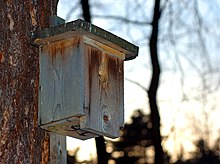Nesting aid



A nesting aid is the term used to describe artificially created facilities that are intended to imitate the nesting possibilities of certain wild animal species. The aim is to support and promote the populations of animal species by installing nesting aids in nature, which have declined due to special requirements for the nesting site in a changed, structurally poorer landscape . In addition, in forestry and fruit growing, the settlement of insect-devouring cave- and niche-breeding songbirds with nesting aids is a measure to counteract the prevalence of pest caterpillars and thus to avoid the ecologically problematic use of insecticides .
Classic examples of nesting aids are nesting caves and nesting boxes as breeding opportunities for the cave breeders and the niche breeders among the birds .
The Thuringian ornithologist Hans Freiherr von Berlepsch (1857–1933) - one of the nestors of bird protection in general - is considered to be the inventor of these nesting aids . Based on the model of the natural woodpecker caves, which are one of the most important homes for cave-breeding birds in the natural forest, Berlepsch constructed a type of nesting cave from trunk pieces of the black alder in several sizes adapted to different bird species. These Berlep nest boxes , which were the first to be machine-made in series, gave the idea of bird protection a great boost. In the course of the decades, various construction variants of nest boxes and boxes were developed. Both the round nest boxes made of logs and the popular, square wooden nest boxes that are easy to make for everyone (see illustration) often only last a few years, mainly because of their susceptibility to weathering. The most suitable nesting aids for bird protection today are those that are industrially manufactured from a mass of cement and coarse sawdust, so-called wood concrete . These nesting devices, first manufactured in the late 1950s, have been developed in various designs over time that take into account the needs of certain bird species and protection against nest predators . Nesting devices made of wood-concrete are produced and sold in Germany by several specialist companies for bird protection products.
So while nesting devices for birds have been hung by conservationists for many decades, in the course of the nature conservation movement of the 1980s, nesting aids were developed for many other animal species and their application was propagated. Nest walls as insect hotels are a special form . Insects that do intensive brood care (many groups of hymenoptera ) usually need suitable cavities in which the offspring can develop undisturbed. Naturally, these are, for example, drill holes in dead wood , cracks in stone or self-dug passages in clay walls . As a substitute, wooden or stone blocks or bundles of hollow plant stems with holes are placed in a location exposed to the south. The construction of insect nesting aids is not only considered a relatively easy way to protect and enrich the native fauna, but also as an opportunity for nature observation and a means of environmental education for children.